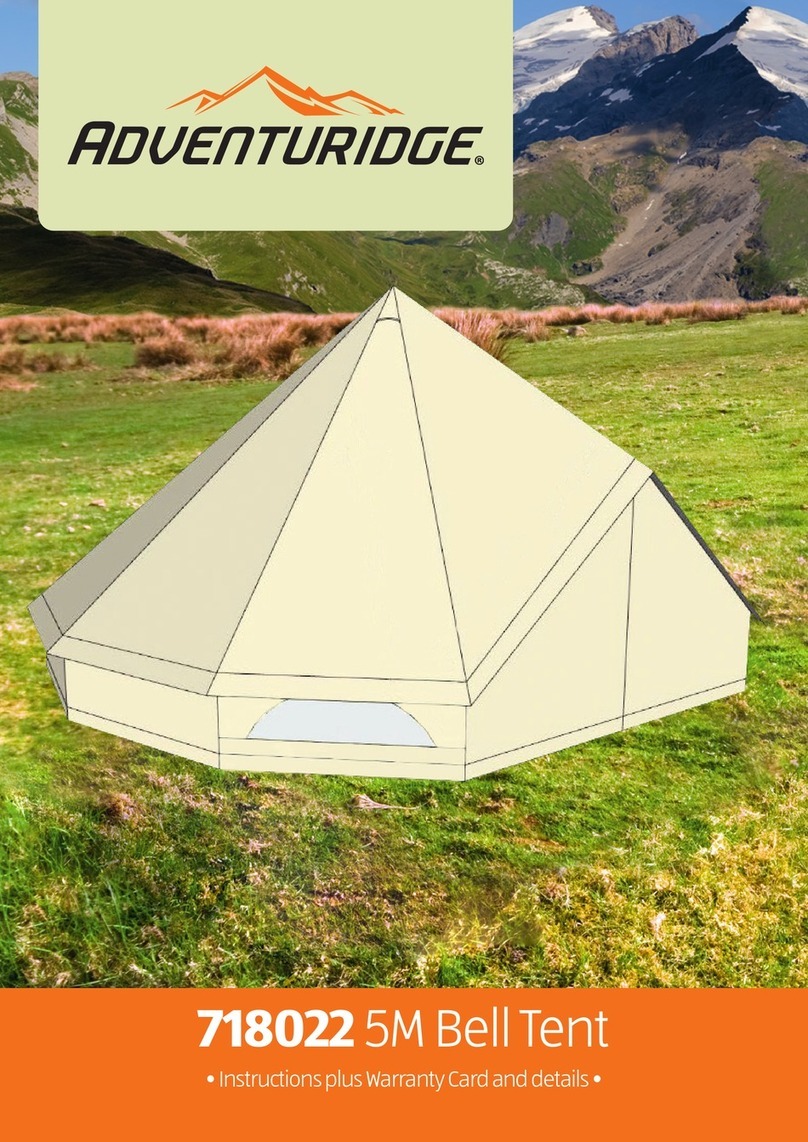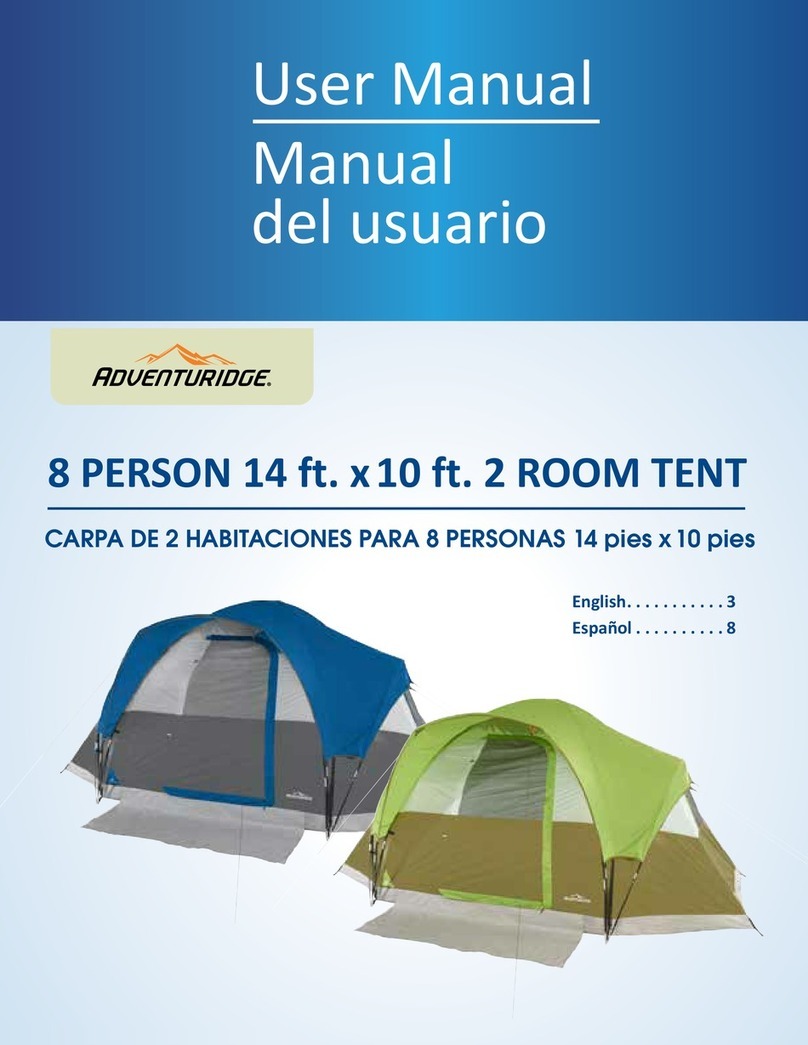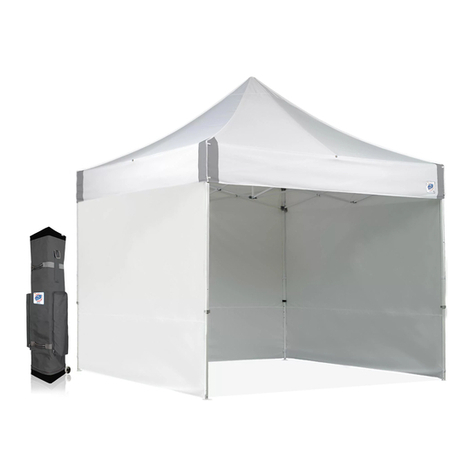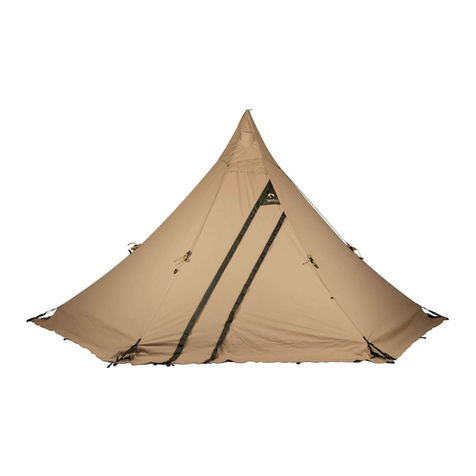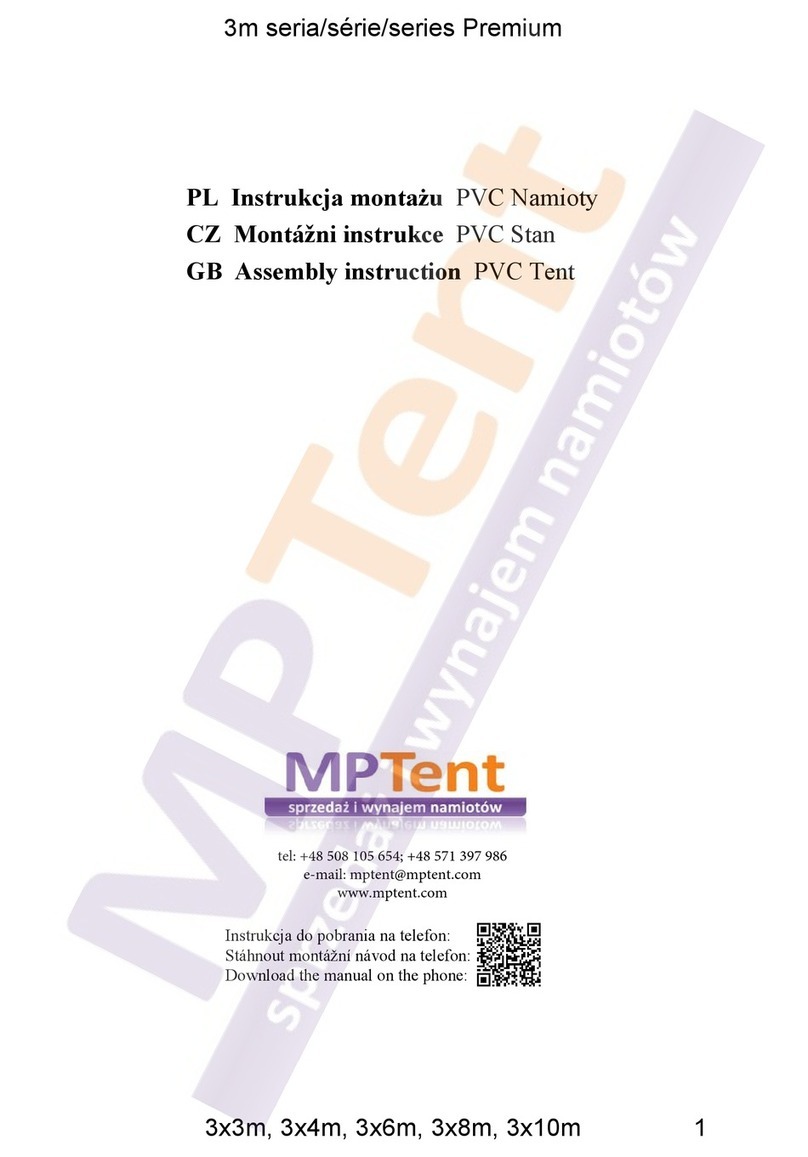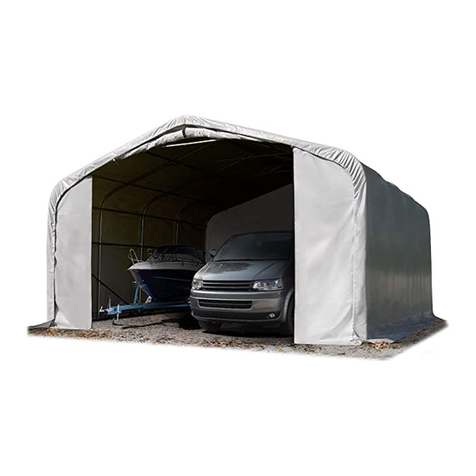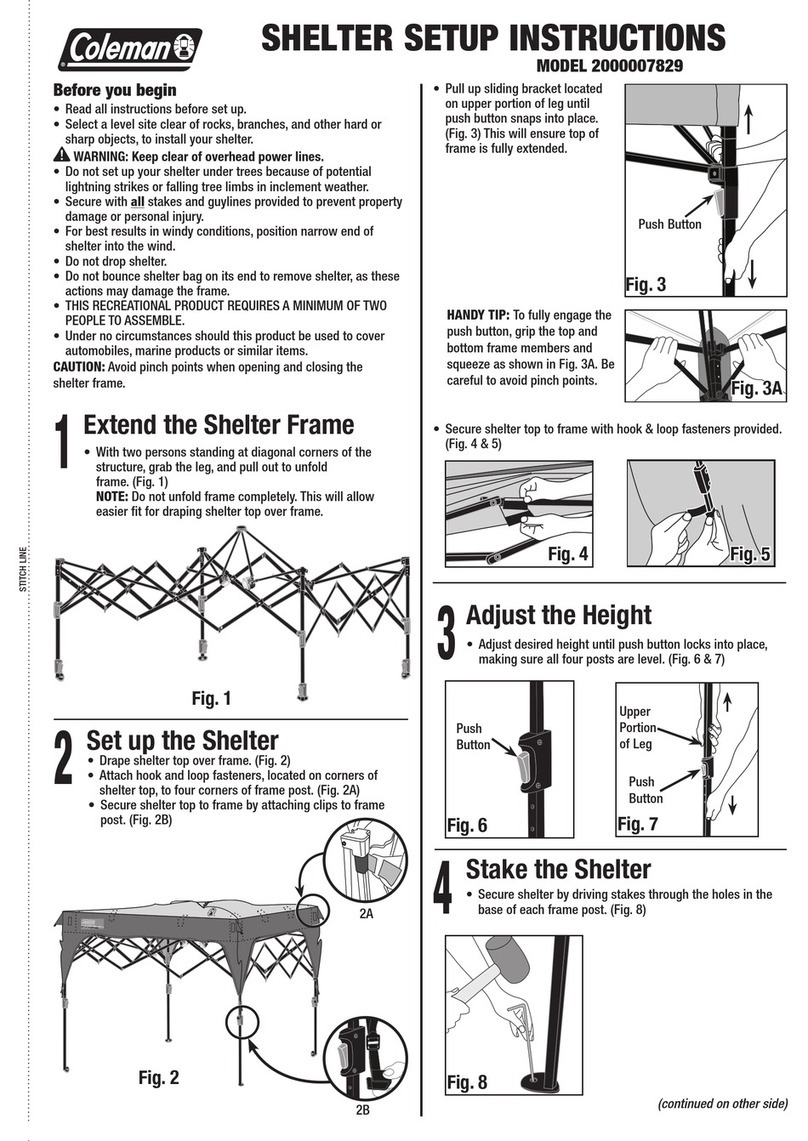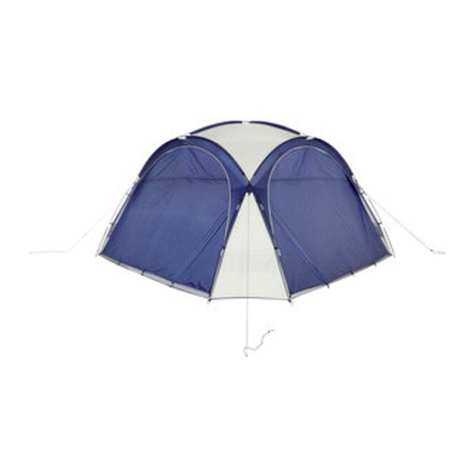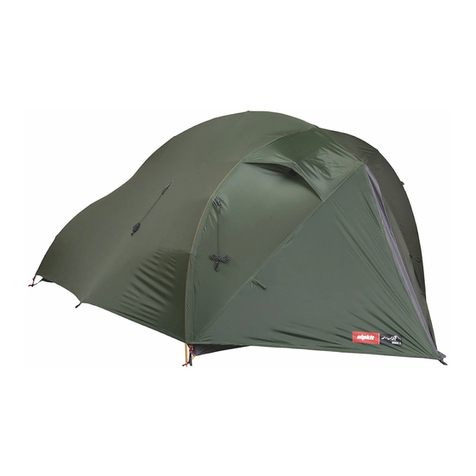Adventuridge FLX-DT-17 User manual

4-PERSON DOME TENT
WITH AWNING
User Manual
ID: #05007
m
y
h
a
n
s
e
c
o
n
t
r
o
l
.
c
o
m
M
A
N
U
A
L
D
E
V
E
L
O
P
E
D
I
N
G
E
R
M
A
N
Y
User-friendly
Manual

QR codes take you where you want to go
quickly and easily
Whether you require product information, spare parts or accessories,
details on warranties or aftersales services, or if you want to watch a
product demonstration video, our QR codes will take you there in no
time at all.
What is a QR code?
A QR code (QR = Quick Response) is a type of matrix that can be read
with a smartphone camera and that contains a link to a website or
contact details, for example.
Advantage: You do not need to manually enter a website address or
contact details.
How it works
To scan the QR code, all you need is a smartphone with QR code reader
software and an internet connection. This type of software can be
downloaded for free from your app store.
Try it out now
Just scan the QR code with your smartphone and find out
more about the ALDI product you have purchased.
Your ALDI Service Portal
All details mentioned above can also be found in the
ALDI Service Portal at www.aldi.co.uk.
Depending on your tariff plan you may be charged for the connection.

Dok./Rev.-Nr. 194813_20170127
Overview .............................................................................4
Use........................................................................................5
Package contents/product parts .......................................6
General information............................................................ 7
Reading and storing the user manual ..................................7
Explanation of symbols ...........................................................7
Safety ...................................................................................8
Proper use................................................................................. 8
Safety instructions................................................................... 9
Checking the tent and package contents .........................11
Use.......................................................................................11
Setting up and taking down the tent...................................11
Attaching the inner tent to the outer tent .......................... 14
Cleaning and care ............................................................. 14
Folding up and storing the tent ....................................... 15
Maintenance and repair.................................................... 16
Technical data ....................................................................17
Disposal...............................................................................17
Disposing of the packaging .................................................. 17
Disposing of the tent .............................................................. 17
Contents

4
A
6
5
1
2
3
4
17
18
16
15
7
8
9
1013
11
12
14
19
10

5
B
FED
HG
C
20
8
20
8
21 2223 22 24
26
25

6
Package contents⁄product parts
1Tunnel guide for the awning
2Guy line, 6× (attached to the tensioning
triangles of the tent when delivered)
3Entrance of the inner tent
4Tent floor
5Tether
6Fastening loop of the inner tent
7Fibreglass pole for the awning
(with grey marks)
8Fibreglass pole for the outer tent, 2×
9Carrying bag
10 Recess (fastening loop of the inner tent)
11 Ground tarpaulin
12 Fastening hook of the ground tarpaulin, 2×
13 Fastening loop of the ground tarpaulin, 2×
14 Peg, 16×
15 Peg bag
16 Pole bag
17 Loop and pin (for attaching the outer
tent to the inner tent), 17×
18 Fastening loop of the outer tent, 7×
19 Awning entrance
20 Tunnel guides for the outer tent, 2×
21 Metal pin (ring-pin system), 4×
22 Fastening hooks for the inner tent, 4×
23 Metal loop for the outer tent, 2×
24 Plastic loop for the outer tent, 2×
25 Side ventilating window, 2×
26 Spacers for ventilating windows, 4×

General information
7
General information
Reading and storing the user manual
This user manual accompanies this 4-person dome tent with awning. It
contains important information about safety, use and care.
For improved readability, the 4-person dome tent with awning will be
referred to only as the “tent” below.
Before setting up the tent, read the user manual carefully. This particularly applies to
the safety instructions. Failure to heed this user manual may result in severe injury or
damage to the tent.
The user manual is based on the standards and rules in force in the European Union.
When abroad, you must also observe country-specific guidelines and laws.
Store the user manual for future use. If you pass the tent on to third parties, please be
absolutely sure to include this user manual.
Explanation of symbols
The following symbols and signal words are used in this user manual, on the tent or
on the packaging.
WARNING! This signal symbol/word designates a hazard with
moderate degree of risk which may lead to death or
severe injury if not avoided.
CAUTION! This signal symbol/word designates a hazard with
low risk that, if not avoided, may result in minor or
moderate injury.
NOTICE! This signal word warns against potential damages to
property.
This symbol provides you with useful additional information regarding
assembly or use.
The total weight of the packed tent amounts to 4.9kg.
The highest point in the inner tent is 125cm.

Safety
8
The outer tent has a water column of 2000mm.
The dimensions of the carrying bag are 57 × 18 × 18cm.
The dimensions of the ground area in the inner tent are 240 × 210cm.
Safety
Proper use
The tent is exclusively designed for outdoor camping with up to four persons in main-
ly mild weather conditions. It is only intended for private use and not suitable for
commercial purposes.
Only use the tent as described in this user manual. Any other use is deemed improper
and may result in damage to property or even personal injury. The tent is not a chil-
dren’s toy.
The manufacturer or vendor accepts no liability for damage caused by improper or
incorrect use.

Safety
9
Safety instructions
WARNING!
Danger of suffocation!
If the inside of the tent is not adequately ventilated, there is a risk
of suffocation.
− Make sure that the vents on the side of the inner tent are not
covered at any time.
− Do not leave children unattended in the tent.
− Do not allow children to play with the packaging wrapper.
They may get caught in it when playing and suffocate.
− Make sure that there is always an unobstructed path of escape
out of the tent.
− Do not allow children to play with the carrying bag.
WARNING!
Risk of injury!
The fibreglass poles have pointy metal ends. Careless and improper
handling of the fibreglass poles may result in injury.
− Keep the fibreglass poles out of the reach of children.
− When handling fibreglass poles, pay attention to nearby persons.
WARNING!
Risk of strangulation!
If the guy lines end up in the hands of children, they could strangle
themselves.
− Do not leave the guy lines lying around when unattended.
− Keep the guy lines out of the reach of children.
− Do not allow children to play with the guy lines.

Safety
10
WARNING!
Risk of fire and burn hazard!
The tent consists of flammable material.
− Do not set up any cooking or heating devices in the tent and do
not hang any lighting fixtures near the walls or roof of the tent.
− Do not place any electric devices (e.g. heaters) that are activat-
ed near or inside the tent.
− Do not use any gas or other combustion devices.
− Keep the tent away from open fire.
− Avoid continual exposure to sunlight to prevent the accumula-
tion of heat inside the tent.
− Keep the entrance of the tent free of obstructions.
− Survey the location of facilities and find out about precautions
to be taken on the tent grounds in the event of a fire.
CAUTION!
Risk of injury!
You could trip over pegs protruding out of the ground. You could
injure yourself in the process.
− Always insert the pegs all the way in the ground.
NOTICE!
Risk of damage!
Faulty set-up and improper handling of the tent may cause dam-
age to the tent.
− Only use the tent in mild weather conditions; do not use it in alpine
or extreme conditions such as hail, flooding, extreme cold or heat.
− Promptly take the tent down in the event of an incoming storm
or thunderstorm. Even if properly anchored, it may come loose.
− Do not use the tent in the event of snow. The tent tarp is not
designed to withstand snow loads and may rip.

Checking the tent and package contents
11
− Stop using the tent if the plastic parts of the tent are deformed,
cracked, chipped or exhibit breaks, splinters or other damages.
− Never expose the tent to high temperatures.
− Never fill liquids into the tent.
− Do not place the tent with the entrance against the wind direc-
tion.
− Do not place any objects over the outer tent.
Checking the tent and package contents
1. Take the tent and all individual accessories out of the packaging.
2. Check to make sure that the delivery is complete (see Fig.A, D, E and F).
3. Check whether the tent or the individual parts exhibit damage. If this is the case,
do not use the tent. Contact the manufacturer at the service address specified on
the warranty card.
Use
Setting up and taking down the tent
NOTICE!
Risk of damage!
If you set up the tent in an unsuitable location or do not secure it
sufficiently, it may be damaged.
− Set up the tent on a dry, level surface on which the guy lines
can be secured.
− Make sure that there are no pointy rocks under the tent floor.
− Make sure that there is enough space around the tent so that
you can secure the tent with the guy lines.
− Do not set up the tent on sloped ground.
− Do not set up the tent on sandy ground. It will not be possible
to securely anchor your tent in sandy ground.

Use
12
NOTICE!
Risk of damage!
Strong wind or a storm may pull the tent out of the anchors and
damage it.
− Set the tent up so that the wind can blow away over the tent
from the back of the tent.
− In addition to the pegs, use the guy lines to secure the tent
and protect it against the wind.
− In the event of intense rain or wind, close the side ventilating
windows by folding the spacers in. Use the hook and loop fas-
teners on the tent to fix the ventilating windows in place.
NOTICE!
Risk of damage!
The tent’s tarp may tear if it is drawn too tight.
− Do not excessively tighten the tent tarp.
• The rear channel ends of the tunnel guides on the outer tent have
been sewn shut so that the tent can be set up by one person.
• Set up the tent before a trip to familiarise with the tent’s construction.
• The net insert in the inner tent permits adequate ventilation and,
at the same time, prevents insects from getting into the tent.
• Once you are finished setting up, make sure that the pegs are
secure and that they do not protrude from the ground.
1. Select a suitable, level set-up location where you can properly secure the tent with
the pegs 14 and the guy lines 2(see Fig.A).
2. Take the tent, the three fibreglass poles 7/8and the pegs out of the carrying
bag 9.
3. Spread the tent out so that the grey underside of the inner tent is facing down at
the set-up location. Make sure that the entrance 3of the inner tent is pointing in
the desired direction.
4. If the inner tent is not buttoned onto the outer tent, button the inner and outer
tent together as described in the chapter “Attaching the inner tent to the outer
tent”. If the inner tent is already buttoned to the outer tent, proceed with step 5.

Use
13
5. Fold the two fibreglass poles 8for the outer tent apart and connect the individ-
ual pole elements in sequence.
6. Run the two fibreglass poles with the plastic end forward into one of the two tun-
nel guides 20 on the outer tent one after another and slide them through to the
end (see Fig.A and B).
7. Lift one of the two fibreglass poles and push it no further into the tunnel guide un-
til you can insert the metal pin 21 into the metal end of the fibreglass pole to fix it
in place (see Fig.B, C and D).
The fibreglass pole will erect itself and is under tension.
8. Repeat this process with the other fibreglass pole.
9. Push the fibreglass pole 7of the awning through the tunnel guide 1on the
awning so that it evenly protrudes on both sides of the tunnel guide.
10. Insert the free metal pin on the one side of the fibreglass pole into the metal end
of the fibreglass pole.
11. Tension the fibreglass pole by sliding it all the way through the tunnel guide and
up against the metal pin. The fibreglass pole will bend.
12. Fix the tensioned fibreglass pole in place by inserting the free metal pin in the
open metal end.
13. Attach the two fastening hooks 22 on the front side of the inner tent to the two
metal loops 23 (see Fig.E).
14. Attach the two fastening hooks on the back of the tent to the plastic loops 24
(see Fig.F).
15. Insert the pegs in the ground through the fastening loop 6of the inner tent
(see Fig.A).
16. Lay the ground tarpaulin 11 in front of the entrance to the inner tent. Align the
recess 10 of the ground tarpaulin with the fastening loop 6of the inner tent.
17. Hook the two fastening hooks of the ground tarpaulin 12 into the two metal
loops on the outer tent.
18. Close the entrances 3/19 of the inner tent and the awning.
19. Use the pegs to secure all fastening loops 18 on the outer tent in the ground.
In the process, keep in mind that the pegs for the fastening loops on the left and
right of the entrance to the awning must also run through the fastening loops 13
of the ground tarpaulin.
20. If applicable, secure the guy line to the tensioning triangles of the outer tent.
21. If necessary, use the guy lines to secure your tent against wind.
22. Open the ventilating windows 25 and secure them with the spacers 26 (see Fig.G).

Cleaning and care
14
Your tent is now ready for use. If you would like to take down the tent, remove all ob-
jects and, if applicable, dirt from the tent and perform all steps in reverse order. If you
would like to fold the tent up and store it, proceed as described in the chapter “Fold-
ing up and storing the tent”.
Attaching the inner tent to the outer tent
If the outer tent and the inner tent are not buttoned together (e.g. after cleaning or
drying), proceed as follows:
1. Spread out the inner tent with the grey underside facing down (see Fig.A and H).
2. Lay the outer tent on the inner tent so that all entrances 3/19 are facing in the
same direction.
3. Connect the loop and pin 17 with one another in the middle of the outer and
inner tent.
4. From the middle, connect the loops of the outer tent with the respective pins of the
inner tent in sequence on all four sides of the tent.
You can now set up the tent as described in the chapter “Setting up the tent”.
To unbutton the inner tent and the outer tent, perform the steps in reverse order.
Cleaning and care
NOTICE!
Risk of damage!
Improperly cleaning the tent may damage it.
− Do not use any aggressive cleaners, brushes with metal or ny-
lon bristles, sharp or metallic cleaning utensils such as knives,
hard scrapers and the like.
− Never wash the tent in the washing machine. It would be de-
stroyed as a result.
− Never have the tent dry cleaned.
− Only use clean water or a commercially-available tent cleaner
to clean the tent.
1. If applicable, remove any dirt from the outer tent with a damp, soft sponge or cloth
with clean water or a commercially-available tent cleaner before taking the tent
down (see Fig.A).

Folding up and storing the tent
15
2. Before taking the tent down, sweep the inner tent and the ground tarpaulin 11
and, if necessary, remove any dirt with a damp, soft sponge or cloth using clean
water or a commercially-available tent cleaner.
3. Let all parts dry completely from the inside and outside.
4. If the inside of the outer tent or the inner tent is wet, unbutton both tents to sep-
arate them as described in the chapter “Attaching the inner tent to the outer tent”
and let both parts dry separately from one another.
5. Remove all pegs 14 .
6. Take all fibreglass poles 7/8out of the tunnel guides 1/20 .
7. Place the tent with the top side down on a smooth, dry and clean surface.
8. Wipe the tent floor 4off with a damp, soft sponge or cloth with clean water or
commercially-available tent cleaner.
9. Let all parts dry completely.
You can now fold the tent up for storage as described in the chapter “Folding up and
storing the tent”.
Folding up and storing the tent
NOTICE!
Risk of mould.
Never fold the tent up when it is wet or dirty. Mould or odour may
form or the material may be discoloured.
− Clean the tent before you fold it up as described in the chapter
“Cleaning and care”.
1. Insert the fibreglass poles 7/8in the pole bag 16 and close it (see Fig.A).
2. Put the pegs 14 in the peg bag 15 and close it.
3. Spread out the tent with the grey underside of the inner tent facing down (see Fig.H).
4. If the outer tent and the inner tent are buttoned together, smooth the outer tent and
fold the corners together so that it is flush with the inner tent. Proceed with step 6.
5. If the outer tent and inner tent are not buttoned together, button them together
as described in the chapter “Attaching the inner tent to the outer tent”.
6. Fold the tent up so that it has the width of the carrying bag.
7. Place the ground tarpaulin, 11 the pole and peg bag in the middle of the tent.
8. Roll the tent up.
9. Store the tent in the carrying bag 9.

Maintenance and repair
16
Maintenance and repair
NOTICE!
Risk of damage
The tent may be damaged as the result of wear.
− Check the tent regularly for rips and damages to the poles,
especially after a prolonged period of non-use. In the event of
damage, repair the tent before you use it again.
Product part Defect/damage Repairs
Outer tent Declining watertightness of the
seams
Use a commercially-available
waterproofing spray to water-
proof the outer tent regularly
or after prolonged storage.
Outer tent Holes and rips in the outer tent Contact the manufacturer at
the service address specified
on the warranty card.
Inner tent Holes and rips in the inner tent Contact the manufacturer at
the service address specified
on the warranty card.
Zippers Sluggish zippers Spray sluggish zippers with
silicon, glycerine or paraffin
so they zip open and closed
smoothly.
Fibreglass poles Damaged or broken fibreglass
poles
Contact the manufacturer at
the service address specified
on the warranty card.

Technical data
17
Technical data
Model: FLX – DT - 17
Category/service level: A2
Dimensions of the outer tent (when erected): 250 × 220 + 80 × 130 cm (W × L × H)
Dimensions of the inner tent (when erected): approx. 240 × 210 × 125 cm (W × L × H)
Outer tent material: 185T 63D polyester with PU coating,
approx. 56 g/m²
Inner tent material: 170T 63 D polyester, approx. 42 g/m²,
breathable
Water column of outer tent: 2,000 mm (waterproof)
Water column of tent floor: 3,000 mm (waterproof)
Article number: 94776
Disposal
Disposing of the packaging
www.recyclenow.com
INLAY - CARD widely recycled
Dispose of the packaging separated into single type materials.
Dispose of cardboard and carton as waste paper and foils via the
recyclable material collection service.
Disposing of the tent
Dispose of the tent in accordance with the applicable regulations for your country.

PRODUCED IN BANGLADESH FOR:
ALDI STORES LTD. PO BOX 26, ATHERSTONE
WARWICKSHIRE, CV9 2SH.
ALDI STORES (IRELAND) LTD.
PO BOX 726, NAAS, CO. KILDARE.
Visit us at www.aldi.com
GB IRE
Great care has gone into the manufacture of this product and it should
therefore provide you with years of good service when used properly.
In the event of product failure within its intended use over the course of the
first 3 years after date of purchase, we will remedy the problem as quickly
as possible once it has been brought to our attention. In the unlikely event
of such an occurrence, or if you require any information about the product,
please contact us via our helpline support services, details of which are to be
found both in this manual and on the product itself.
YEARS
WARRANTY
3
MODEL:
FLX – DT - 17
flexxtrade-gb@teknihall.com
00800 / 78747874
AFTER SALES SUPPORT
IREGB
94776
05/2017
GB
IRE flexxtrade[email protected]
Table of contents
Other Adventuridge Tent manuals
Popular Tent manuals by other brands
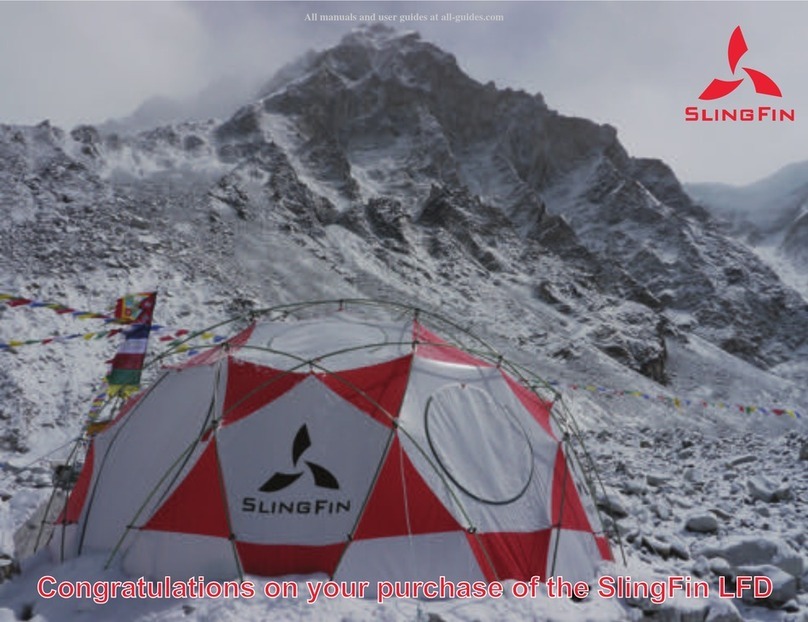
SlingFin
SlingFin LFD manual

Boutique Camping
Boutique Camping OXFORD BELL TENT instruction manual

Décor et Jardin
Décor et Jardin Gamagran 81801S000 Assembly Notice

Dometic
Dometic Mobil AIR PRO 361 Installation and operating manual

Kathmandu
Kathmandu Boreas v2 instruction manual
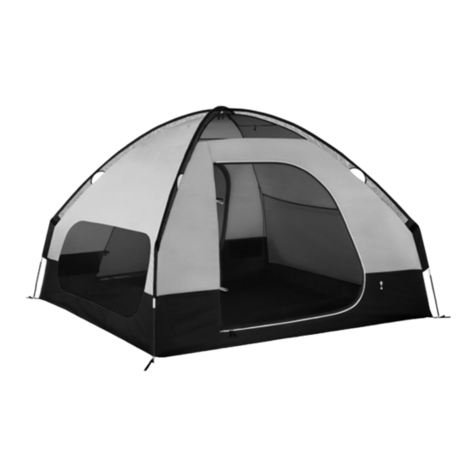
Eureka
Eureka Grand Manan 7 Assembly instructions
